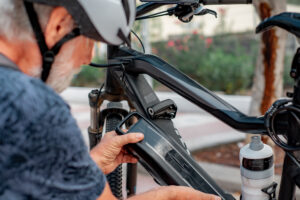
E-Bike Lithium-Ion Battery Fires: 8 Safety Tips & When to Use Lith-X Extinguishers
E-bikes and e-scooters are everywhere, but their lithium-ion batteries have become London’s fastest-growing fire risk. The London Fire Brigade attended one blaze every two days in 2023 . Across the UK, 11 people sadly died in battery-related fires last year . Understanding the danger—and picking the right extinguisher—has never mattered more.
Why Lithium-Ion Fires Behave Differently
Unlike traditional fires, a lithium-ion cell can enter thermal runaway, creating its own oxygen and reaching 1,000 °C in seconds. Conventional foam or CO2 extinguishers rarely penetrate deep enough to stop the reaction .
Eight Essential Charging & Storage Tips
- Buy CE/UKCA-marked batteries and chargers—see the latest statutory UK guidelines.
- Charge on a hard, non-combustible surface—never on soft furnishings.
- Use a single, fused wall socket—avoid daisy-chained extensions.
- Fit heat-alarm detectors near charging points.
- Stop charging once the indicator turns green.
- Quarantine any swollen, hissing or hot battery immediately.
- Keep bikes and batteries clear of escape routes.
- Never leave charging unattended; if a fire starts, GET OUT / STAY OUT / CALL 999 .
Lithium-Ion ≠ Lithium Metal
Lithium-ion packs in e-bikes contain no free lithium metal, so they are not classed as a metal fire . Class D powders such as Lith-X by Ansul or L2 are engineered for metallic lithium chips, swarf or ingots and will smother rather than cool a runaway battery .
When to Deploy a Lith-X Extinguisher
Lith-X is a graphite-based powder, UL-listed for temperatures up to 2,000 °C . Use it for:
- Primary (non-rechargeable) lithium button-cells or cylindrical metal batteries
- Laboratory spills of lithium chips or shavings
- Machining or casting areas where lithium metal is present
It is not recommended for laptop, power-tool, e-bike or EV battery packs; see the FIA’s lithium-ion battery fire guidance .
How Lith-X Works
The powder flows at low velocity, forming a crust that insulates the metal from oxygen and wicks away heat, preventing re-ignition .
Better Options for Lithium-Ion Batteries
- AVD “Lith-Ex” extinguishers—a water-based mist that cools cells and coats them in a non-conductive film. See our Home Fire Extinguisher Guide for details .
- Water-mist units—fine droplets absorb heat rapidly with minimal collateral damage .
30-Second Emergency Plan
- Cut power if safe.
- Evacuate, closing doors behind you.
- Tell 999 it’s a lithium-ion battery fire so crews bring specialist media .
Need Expert Help?
Total Safe UK now offers a Battery Safety Audit – including charger locations, load calculations and extinguisher selection—as part of our Fire Risk Assessment service. We also provide fire-extinguisher maintenance to ensure your protection is always ready. Call 01375 265 950 or email [email protected] to book.
For everyday charging tips, download the Battery Safety for E-Cycle Users leaflet.
